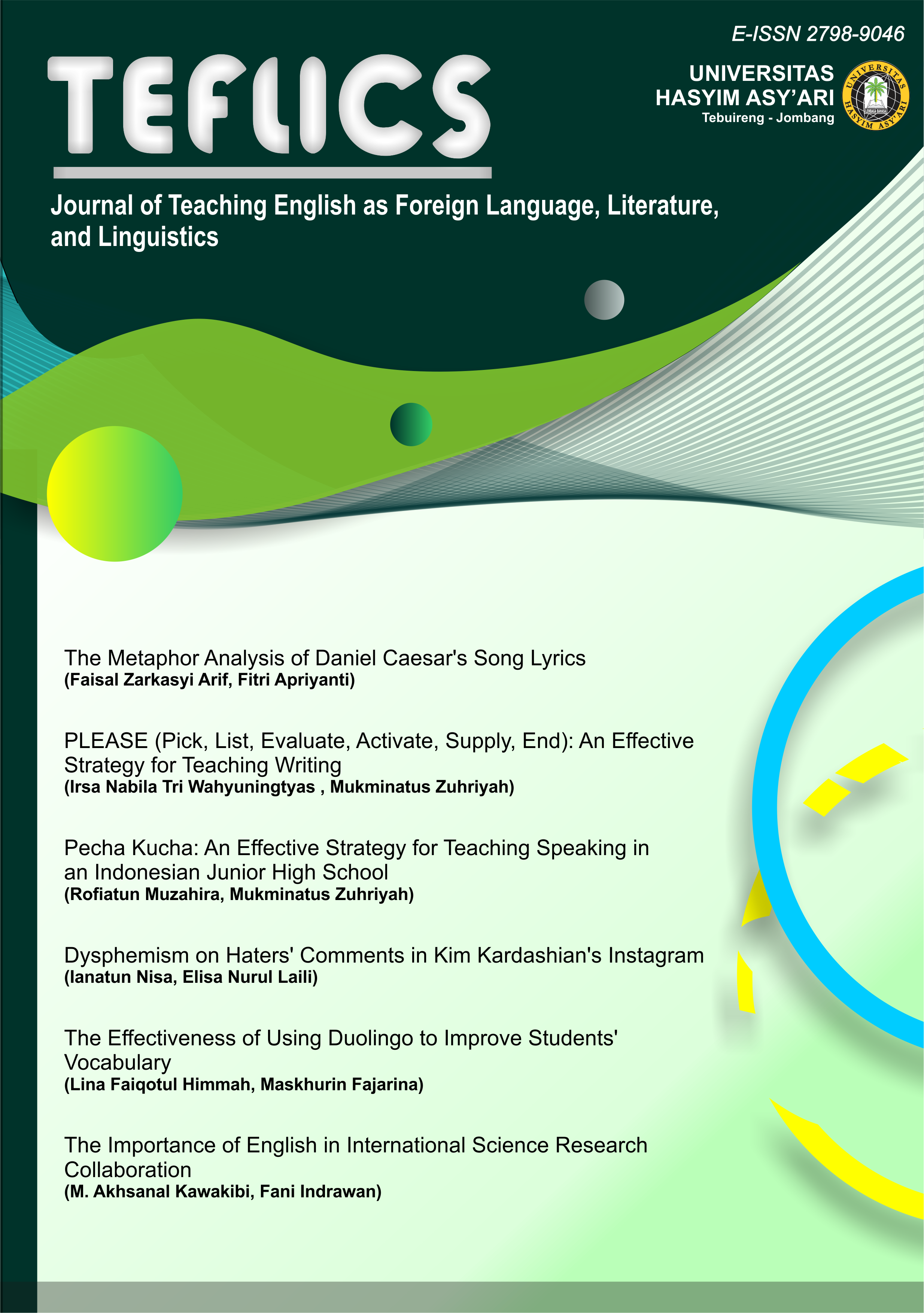Dysphemism on Haters' Comments in Kim Kardashian's Instagram
DOI:
https://doi.org/10.33752/teflics.v4i1.6213Keywords:
Dysphemism, Haters, Kim Kardashian'sAbstract
Language serves as a pivotal tool in communication, facilitating the exchange of information, ideas, and emotions. Dysphemism, the use of offensive language to insult or belittle, is prevalent in online interactions, particularly on social media platforms. This study delves into dysphemism within the context of haters' comments on Kim Kardashian's Instagram account. Drawing from a qualitative research design, the study identifies eight types and nine functions of dysphemism prevalent in these comments. These include the use of taboo terms, profane swearing, comparisons to animals, epithets targeting physical characteristics, and more. Furthermore, dysphemistic emojis are analyzed alongside textual dysphemisms, revealing a nuanced layer of expression. The research underscores the significance of understanding dysphemism in online discourse, shedding light on its forms, meanings, and functions. Suggestions for future research include exploring dysphemism across various social media platforms and conducting more comprehensive analyses to enrich our understanding of this linguistic phenomenon.
Downloads
References
References
Allan, K., & Burridge, K. (1991). Euphemism & dysphemism: Language used as shield and weapon. (Euphemism & Dysphemism: Language Used as Shield and Weapon).
Ayupradani, N. T., Kartini, E. R., Minastiti, S., & Pratiwi, D. R. (2021). Ujaran Disfemisme dalam Twitter @FiersaBesari Mengenai Kritikan kepada Pemerintah. Seminar Nasional Saga, 3(1), 63–71.
Bakhtiar, A., Rinata, B., Sukamto, K., Hidayat, S., & Pramono, S. (2022). Efektivitas Penggunaan Emoji Dalam Komunikasi Digital. Universitas Negeri Surabaya 2022 |, 620, 620–632.
Boyd, D. M., & Ellison, N. B. (2007). Social network sites: Definition, history, and scholarship. Journal of Computer‐mediated Communication, 13(1), 210–230.
Crystal, D. (2003). English as a global language. Cambridge university press.
Gumperz, J. J. (1972). Directions in sociolinguistics: The ethnography of communication. Holt, Rinehart and Winston.
Halliday, M. A. K. (1978). Language as social semiotic. Edward Arnold London.
Handayani, M. T. (2020a). Disfemisme dalam Kolom Komentar Akun Instagram@ Officialkvibes.
Handayani, M. T. (2020). Fungsi Penggunaan Disfemisme Dalam Kolom Komentar Akun Instagram @Officialkvibes. Nuansa Indonesia, 22(2), 134. https://doi.org/10.20961/ni.v22i2.46117
Huberman, M., & Miles, M. B. (2002). The qualitative researcher’s companion. sage.
Laili, E. N. (2017). Disfemisme Dalam Perspektif Semantik, Sosiolinguistik, Dan Analisis Wacana. LiNGUA: Jurnal Ilmu Bahasa Dan Sastra, 12(2), 110–118. https://doi.org/10.18860/ling.v12i2.4038
Laili, E. N., Sawardi, F. X., & Nisa’Khusnia, A. (2023). KONSEPTUALISASI DISFEMISME DALAM NOVEL LAUT BERCERITA: SEBUAH TINJAUAN SEMANTIK KOGNITIF. Sirok Bastra, 11(2), 149–164.
Letters, E., Departement, L., & Humanities, F. O. F. (2009). Dysphemism Used in Green Day ’ S and Slipknot ’ S Lyrics.
Rahmawati, L. E., & Ariesta, W. (2020). Dysphemism in Online News Headlines: Student Demonstrations. PalArch’s Journal of Archaeology of Egypt/Egyptology, 17(6), 908–915.
Song, L. (2010). The Role of Context in Discourse Analysis. Journal of Language Teaching and Research, 1(6), 876–879. https://doi.org/10.4304/jltr.1.6.876-879
Sugiyono, D. (2013). Metode penelitian pendidikan pendekatan kuantitatif, kualitatif dan R&D.
Ulum, D. E. L., & Kusmanto, H. (2018). Disfemia pada Komentar Akun Instagram Mimi.Peri. Seminar Nasional Kajian Bahasa, Sastra, Dan Pengajarannya (SEMNAS KBSP) V, 232–237.
United Nations. (2020). Human Rights We are all in this together Human rights are critical – for the response and the recovery. United Nations, April, 22. https://www.un.org/sites/un2.un.org/files/un_policy_brief_on_human_rights_and_covid_23_april_2020.pdf
Widdowson, H. G. (2000). On the limitations of linguistics applied. Applied Linguistics, 21(1), 3–25.
Yule, G. (2000). Spontaneous spoken language: Syntax and discourse: Jim Miller and Regina Weinert, Oxford: Clarendon, 1998. 457 pp. North-Holland.
















